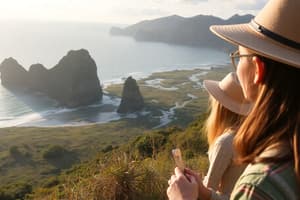Podcast
Questions and Answers
Eco-friendly accommodations can include solar-powered resorts.
Eco-friendly accommodations can include solar-powered resorts.
True (A)
Tourists have no responsibility to respect local customs when visiting new destinations.
Tourists have no responsibility to respect local customs when visiting new destinations.
False (B)
Informational signage can help tourists promote responsible behaviors.
Informational signage can help tourists promote responsible behaviors.
True (A)
Data analytics in tourism management can help optimize resource allocation.
Data analytics in tourism management can help optimize resource allocation.
Participants in conservation efforts cannot choose tour operators that contribute to local initiatives.
Participants in conservation efforts cannot choose tour operators that contribute to local initiatives.
Technology, like apps, can provide information on local conservation projects.
Technology, like apps, can provide information on local conservation projects.
Training local guides to share their stories can enhance the authenticity of cultural experiences.
Training local guides to share their stories can enhance the authenticity of cultural experiences.
Reducing plastic use is not considered a positive behavior for tourists.
Reducing plastic use is not considered a positive behavior for tourists.
Sustainable tourism in the Philippines does not focus on cultural preservation.
Sustainable tourism in the Philippines does not focus on cultural preservation.
Eco-tourism encourages responsible travel and benefits local communities by promoting conservation.
Eco-tourism encourages responsible travel and benefits local communities by promoting conservation.
Cultural tourism in the Philippines aims to exploit local traditions for profit.
Cultural tourism in the Philippines aims to exploit local traditions for profit.
Community-based tourism allows local residents to directly benefit from tourism-related spending.
Community-based tourism allows local residents to directly benefit from tourism-related spending.
Responsible travel practices do not include educating tourists about their environmental impact.
Responsible travel practices do not include educating tourists about their environmental impact.
Governments can implement measures like caps on visitor numbers to protect sensitive areas.
Governments can implement measures like caps on visitor numbers to protect sensitive areas.
The three core pillars of sustainable tourism are environmental stewardship, economic viability, and social isolation.
The three core pillars of sustainable tourism are environmental stewardship, economic viability, and social isolation.
Palawan is an example of a region in the Philippines where eco-tourism initiatives help protect biodiversity.
Palawan is an example of a region in the Philippines where eco-tourism initiatives help protect biodiversity.
Flashcards
Eco-friendly Accommodations
Eco-friendly Accommodations
Hotels and resorts that minimize their environmental impact using sustainable practices like solar power, water conservation, and recycling.
Trails and Viewing Platforms
Trails and Viewing Platforms
Paths and observation areas designed to limit erosion and protect wildlife habitats.
Tourist Education Programs
Tourist Education Programs
Activities that teach visitors about local ecosystems, conservation efforts, and responsible tourism practices.
Responsibilities of Tourists
Responsibilities of Tourists
Signup and view all the flashcards
Participating in Conservation Efforts
Participating in Conservation Efforts
Signup and view all the flashcards
Leveraging Digital Platforms
Leveraging Digital Platforms
Signup and view all the flashcards
Data Analytics for Tourism Management
Data Analytics for Tourism Management
Signup and view all the flashcards
Ensuring Authentic Experiences
Ensuring Authentic Experiences
Signup and view all the flashcards
Sustainable Tourism
Sustainable Tourism
Signup and view all the flashcards
Eco-tourism
Eco-tourism
Signup and view all the flashcards
Cultural Tourism
Cultural Tourism
Signup and view all the flashcards
Community-Based Tourism
Community-Based Tourism
Signup and view all the flashcards
Responsible Travel Practices
Responsible Travel Practices
Signup and view all the flashcards
Balancing Tourism Growth with Environmental Protection
Balancing Tourism Growth with Environmental Protection
Signup and view all the flashcards
Visitor Caps
Visitor Caps
Signup and view all the flashcards
Designated Tourist Zones
Designated Tourist Zones
Signup and view all the flashcards
Study Notes
Sustainable Tourism Strategies in the Philippines
- The Philippines, a diverse archipelago, attracts millions of tourists annually.
- This influx presents challenges, including environmental damage and cultural dilution.
- Sustainable tourism strategies are crucial to preserve natural and cultural resources.
Understanding Sustainable Tourism
- Sustainable tourism aims to minimize negative impacts while maximizing benefits for local communities and ecosystems.
- The core pillars are environmental stewardship, economic viability, and social equity.
- In the Philippines, this implies ensuring tourism preserves, rather than exploits, natural habitats and local cultures.
Key Strategies
Eco-tourism
- Eco-tourism emphasizes responsible travel to natural areas.
- It promotes conservation efforts and benefits local communities.
- Initiatives in regions like Palawan protect biodiversity while providing economic opportunities through guided tours and sustainable practices.
Cultural Tourism
- Cultural tourism promotes authentic experiences that respect and celebrate local traditions.
- Tourists can gain deeper insights into Filipino culture by engaging with indigenous communities and witnessing their heritage.
- This fosters appreciation and respect.
Community-Based Tourism
- This strategy empowers local communities to manage tourism resources.
- Locals benefit directly from visitor spending.
- Community-led initiatives in areas like Batanes preserve unique cultural practices, providing a sustainable income for residents.
Responsible Travel Practices
- Educating tourists about minimizing their environmental footprint is essential.
- This includes actions like reducing waste, supporting local businesses, and respecting cultural norms.
Balancing Tourism Growth with Environmental Protection
- Governments can implement visitor caps, establish permits, and promote off-peak travel in sensitive areas.
- This helps distribute visitors more evenly across regions.
- Designing sustainable infrastructure, such as eco-friendly accommodations and improved public transport, minimizes environmental impacts.
- Trails and viewing platforms must be carefully planned to limit erosion and protect wildlife habitats.
- Tourist education programs, including guided eco-tours, signage, and workshops, can promote responsible behaviors.
The Role of Tourists in Promoting Sustainable Tourism
- Tourists should research destinations beforehand.
- They should respect local customs and guidelines set by local communities.
- Tourists must be mindful of waste and resource consumption.
- Engaging in conservation efforts, like beach clean-ups, helps support local communities.
- Tourists should choose tour operators who contribute to local conservation efforts.
- Tourists should adopt positive behaviors, like reducing plastic use, supporting local artisans, and choosing eco-friendly transportation.
Technology's Role in Enhancing Sustainable Tourism
- Social media can showcase initiatives and lesser-known destinations.
- Influencers can promote responsible practices.
- Innovative apps provide information on local conservation projects, eco-friendly accommodations, and sustainable activities.
- GPS and mapping tools guide tourists to sustainable sites.
- Data analytics can help optimize resource allocation, identify peak times, and manage visitor numbers effectively.
Cultural Preservation Amidst Tourism
- Tour operators should work directly with local communities to create tours that accurately represent cultural practices.
- Training local guides to share stories enhances authenticity.
- Establishing guidelines for cultural representation, including local input, minimizes exploitation.
- Legal protections for cultural heritage sites help ensure preservation.
- Creating platforms for local storytelling through workshops and cultural events can deepen cultural insights.
Evaluating the Impact of Sustainable Tourism
- Success can be measured by indicators like biodiversity health, community income, tourist satisfaction, and the number of sustainable practices adopted.
- Long-term economic benefits are assessed by comparing revenue from sustainable initiatives to traditional tourism models.
- Case studies and longitudinal studies offer valuable insights into sustainable tourism impact.
Challenges and Solutions
- Stakeholders may face funding limitations and training gaps regarding sustainable practices.
- Collaborative partnerships with NGOs, government incentives, and training programs help overcome these.
Studying That Suits You
Use AI to generate personalized quizzes and flashcards to suit your learning preferences.




